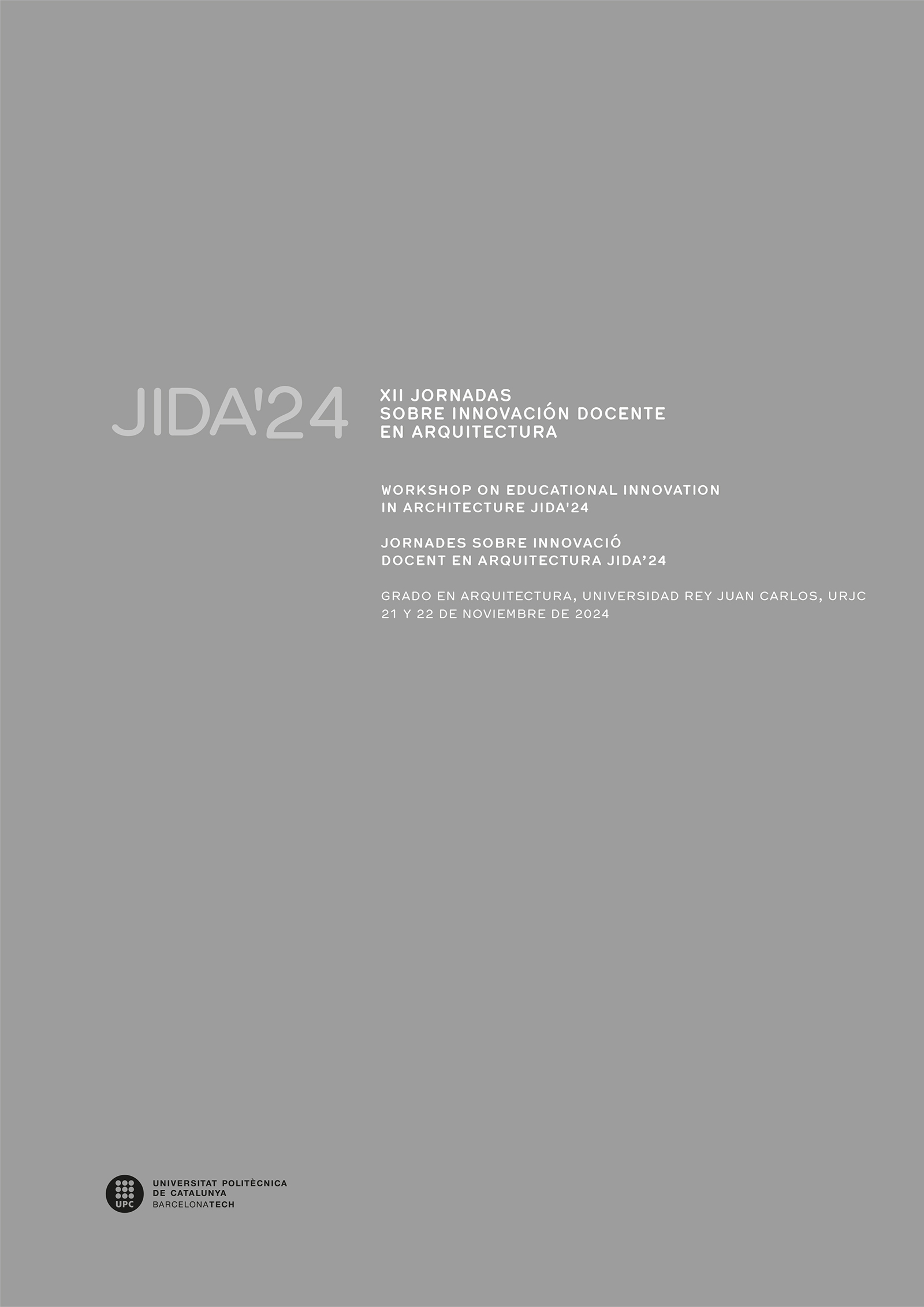Graphic Construction and Communication of Architecture: learning with Augmented Reality
DOI:
https://doi.org/10.5821/jida.2024.13287Keywords:
augmented reality, project-based learning, flipped classroom, peer learning, architectural drawingAbstract
Students of Architectural Drawing face the challenge of mastering a regulated drawing to know, devise and communicate architecture in a brief period, also applying it as a graphic language to articulate their architectural thinking. This process requires the integration of architectural thought and representation, a complex task that has been sought to facilitate through Augmented Reality (AR). An educational experience is presented in the first year of the bachelor's degree in architecture, in which AR technologies and active pedagogical methodologies are combined to improve students' spatial understanding and communication skills. The use of AR allows the analysis of complex architectural objects to be tackled more effectively. The incorporation of these modern technologies seeks to optimize the teaching-learning process and increase the motivation of students, as a resource for their training.
References
Abu Alatta, R. T., y Freewan A. 2017. Investigating the effect of employing immersive virtual environment on enhancing spatial perception within design process. International Journal of Architectural Research Archnet-IJAR, 11: 219-238.
Álvaro-Tordesillas, A., y Montes Serrano, C. 2014. El dibujo en la enseñanza de arquitectura: el boceto manual y el modelo fotogramétrico. En: Almeida, P. L., Duarte, M. B., y Barbosa, J. T. (eds.). DUT'13: Drawing in the University Today, 399-404. Porto: i2ADS-Instituto de Investigação em Arte, Design e Sociedade. https://i2ads.up.pt/wp-content/uploads/2018/01/DUT2013_lo.pdf
Canet-Roselló, J., Elabert-Amengual, A., Juanes-Juanes, B., y Pascual-García, M. 2018. V Grand Tour: La realidad virtual para el aprendizaje de proyectos arquitectónicos. En García Escudero, D., Bardí Milà, B. (eds.) VI Jornadas sobre Innovación Docente en Arquitectura (JIDA'18), Escuela de Ingeniería y Arquitectura de Zaragoza, 22 y 23 de Noviembre de 2018, 488-497. Barcelona: UPC IDP, GILDA; Servicio de Publicaciones de la Universidad de Zaragoza. https://doi.org/10.5821/jida.2018.5509
Darwish, M., Kamel, S., y Assem, A. 2023. Extended reality for enhancing spatial ability in architecture design education. Ain Shams Engineering Journal 14: 1-13. https://doi.org/10.1016/j.asej.2022.102104
Fonseca Escudero, D., Redondo Domínguez, E. y Valls, F. 2016. Motivación y mejora académica utilizando realidad aumentada para el estudio de modelos tridimensionales arquitectónicos. Education in the Knowledge Society EKS, 17(1): 45-64. https://doi.org/10.14201/eks20161714564
Hajirasouli, A. y Banihashemi, S. 2022. Augmented reality in architecture and construction education: state of the field and opportunities. International Journal of Educational Technology in Higher Education 19(1). https://doi.org/10.1186/s41239-022-00343-9
López González, C., García Valldecabres, J. L. y Girbés Pérez, J. 2021. El método Flipped Classroom en asignaturas gráficas. I Congreso de Escuelas de Edificación y Arquitectura Técnica de España. https://doi.org/10.4995/edificate2021.2021.13273
Maldonado Plaza, E. 2016. Estrategias de implantación de enseñanza BIM en estudios de postgrado. Experiencia en la Universidad Politécnica de Madrid. Spanish Journal of Building Information Modeling, 16(1): 30-39.
Papanastasiou, G., Drigas, A., Skianis, C., Lytras, M. y Papanastasiou, E. 2019. Virtual and augmented reality effects on K-12, higher and tertiary education students’ twenty-first century skills. Virtual Reality, 23: 425-436. https://doi.org/10.1007/s10055-018-0363-2
Redondo Domínguez, E. 2010. Dibujo digital: hacia una nueva metodología docente para el dibujo arquitectónico: un estudio de caso. Revista Pixel-Bit. Revista de Medios y Educación, 38: 91-104.
Redondo Domínguez, E. y Santana Roma, G. 2010. Teaching methodologies based on touch interfaces for the teaching of drawing and architectural projects. Arquitetura revista, 6(2): 90-105. https://doi.org/10.4013/arq.2010.62.02
Rodríguez Esteban, M. A., Frechilla-Alonso, M. A. y Sáez Pérez, M. P. 2018. Implementación de la evaluación por pares como herramienta de aprendizaje en grupos numerosos. Experiencia docente entre universidades. Advances in Building Education 2(1): 66. https://doi.org/10.20868/abe.2018.1.3694
Sánchez Canales, M., García Aranda, C., Morillo Balsera, M. C. y Sánchez de la Muela, A. 2019. Clasificación de los diferentes modelos de Aula invertida y su aplicación en la Universidad Politécnica de Madrid. Aprendizaje, innovación y cooperación como impulsores del cambio metodológico. V congreso internacional sobre aprendizaje, innovación y cooperación, CINAIC. https://doi.org/10.26754/CINAIC.2019.0124
Wagemann, E., y Martínez, J. 2022. Realidad Virtual (RV) inmersiva para el aprendizaje en arquitectura. EGA Expresión Gráfica Arquitectónica, 27: 110-123. https://doi.org/10.4995/ega.2022.15581






















